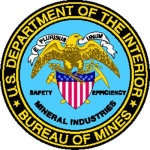- Отрасли: Mining
- Number of terms: 33118
- Number of blossaries: 0
- Company Profile:
The U.S. Bureau of Mines (USBM) was the primary United States Government agency conducting scientific research and disseminating information on the extraction, processing, use, and conservation of mineral resources.
Founded on May 16, 1910, through the Organic Act (Public Law 179), USBM's missions ...
A group of folds showing common characteristics and trends and presumably of common origin.
Industry:Mining
A group of intermetallic compounds of potential interest as special ceramics. Cell dimensions and types of structure have been reported for the beryllides of titanium, vanadium, chromium, zirconium, niobium, molybdenum, hafnium, and tantalum.
Industry:Mining
A group of islands having a curving, arclike pattern. Most island arcs lie near the continental masses, but inasmuch as they rise from the deep ocean floors, they are not a part of the continents proper.
Industry:Mining
A group of isomorphous minerals consisting of olivine, chondrodite, humite, and clinohumite, and closely resembling one another in chemical composition, physical properties, and crystallization.
Industry:Mining
A group of mafic and ultramafic igneous rocks ranging from spilite and basalt to gabbro and peridotite, including rocks rich in serpentine, chlorite, epidote, and albite derived from them by later metamorphism, whose origin is associated with an early phase of the development of a geosyncline. The term was originated by Steinman in 1905.
Industry:Mining
A group of mafic plutonic rocks composed of calcic plagioclase, feldspathoids, and augite, with lesser amounts of sodic sanidine and sodic amphiboles and accessory olivine; also, any rock in that group; the intrusive equivalent of tephrite. Theralite grades into nepheline monzonite with an increase in the alkali feldspar content, into gabbro as the feldspathoid content diminishes, and into diorite with both fewer feldspathoids and increasingly sodic plagioclase. The term, defined by Rosenbusch in 1887, is derived from the Greek word for eagerly looked for, not from the island of Thera (Santorini).
Industry:Mining
A group of minerals comprising the feldspars and feldspathoids. Compare: feldspathoid.
Industry:Mining
A group of minerals found together in a rock, esp. in a sedimentary rock.
Industry:Mining
A group of mountain ranges exhibiting certain unifying features, such as similarity in form, structure, and alignment, and presumably originating from the same general causes; esp. a series of ranges belonging to an orogenic belt. Compare: mountain chain.
Industry:Mining
